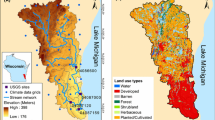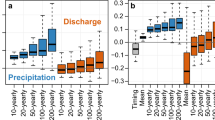Abstract
A continuous flow simulation model(CLASSIC) has been used to assess the potential impactof climate and land use changes on the flood regimesof large U.K. catchments. Climate change scenarios,based on the HadCM2 experiments from the HadleyCentre, are applied to the Severn and Thames rivers.The analysis shows that, for the 2050s, the climatechange scenarios result in an increase in both thefrequency and magnitude of flooding events in theserivers. The various ways of applying the rainfallscenario can have a significant effect on thesegeneral conclusions, although generally do not affecteither the direction or consistency of the changes.While ‘best guess’ land use changes show little impacton flood response, a 50% increase in forest covercould counter-act the impact of climate change. Aswould be expected, a large change in the urban coverof the catchments does have a large effect on theflood regimes, increasing both the frequency andmagnitude of floods significantly beyond the changesdue to climate alone. Further research is requiredinto the potential impacts of seasonal changes in thedaily rainfall and potential evaporation regimes, landuse changes and the interaction between the two.
Similar content being viewed by others
References
Arnell, N. W., Reynard, N. S., King, R., Prudhomme, C. P., and Branson, J.: 1997, Effects of Climate Change on River Flows and Groundwater Recharge: Guidelines for Resource Assessment, Report to UKWIR/Environment Agency.
Climate Change Impacts Review Group: 1996, Review of the Potential Effects of Climate Change in the United Kingdom, The Stationery Office, London.
Crooks, S. M., Naden, P. S., Broadhurst, P., and Gannon, B.: 1996, Modelling the Flood Response of Large Catchments: Initial Estimates of the Impacts of Climate and Land Use Change, Report to U.K. Ministry of Agriculture, Fisheries and Food, p. 66.
Fuller, R. M.: 1993, ‘The Land Cover Map of Great Britain’, Earth Space Review 2, 13–18.
Gannon, B.: 1995, Automating Areal Rainfall Calculations for Catchments, Internal Report, Institute of Hydrology, Wallingford, p. 44.
Hadley Centre: 1997, Climate Change and Its Impacts: A Global Perspective, Department of the Environment, Transport and the Regions/Met. Office, Bracknell.
Hulme, M. and Jenkins, G. J.: 1998, Climate Change Scenarios for the U.K.: Scientific Report, UKCIP Technical Report No. 1, Climatic research Unit, Norwich, p. 80.
Hulme, M., Conway, D., Jones, P. D., Jiang, T., Barrow, E. M., and Turney, C.: 1995, ‘Construction of a 1961–1990 European Climatology for Climate Change Modelling and Impact Applications’, Int. J. Climatol. 15, 1333–1363.
InstitutionalAuthorNameIntergovernmental Panel on Climate Change (1996) Climate Change 1995 J. T. Houghton L. G. Miera Filho B. A. Callander N. Harris A. Kattenburg K. Maskell (Eds) The Science of Climate Change Cambridge University Press Cambridge
Intergovernmental Panel on Climate Change: 1996b, ‘Climate Change 1995’, in Watson, R. T., Zinyowera, M. C., Moss, R. H., and Dokken, D. J. (eds.), Impacts, Adaptations and Mitigation of Climate Change, Cambridge University Press, Cambridge.
Jones, S. B.: 1983, The Estimation of Catchment Average Point Rainfall Profiles, Report No. 87, Institute of Hydrology, Wallingford, p. 34.
Monteith, J.: 1965, ‘Evaporation and Environment’, Symp. Soc. Experiment. Biol. 19, 225–234.
Naden, P. S., Crooks, S. M., and Broadhurst, P.: 1996, ‘Impact of Climate and Land Use Change on the Flood Response of Large Catchments’, in Proceedings of the 31st MAFF Conference of River and Coastal Engineers, Keele, 2.1.1–2.1.16.
Reynard, N. S.: 1997, ‘Climate Change: Issues, Implications and Impacts’, Paper to IBC Ltd. Conference on Water Resources and Management, London, December 1997.
Reynard, N. S., Prudhomme, C., and Crooks, S. M.: 1998a, Climate Change Impacts for Fluvial Flood Defence, Report to U.K. Ministry of Agriculture, Fisheries and Food, p. 43.
Reynard, N. S., Prudhomme, C., Faulkner, D. S., Robson, A. J., and Reed, D. W.: 1998b, Climate Change and the Frequency of Short-Duration Heavy Rainfall in Central England, Report to Severn-Trent Water plc, p. 48.
Robson, A. J., Jones, T. K., Reed, D. W., and Bayliss, A. C.: 1998, ‘A Study of National Trend and Variation in U.K. Floods’, Int. J. Climatol. 18, 165–182.
Thompson, N., Barrie, I. A., and Ayles, M.: 1981, The Meteorological Office Rainfall and Evaporation Calculation System (MORECS), Hydrological Memorandum 45, Met. Office, Bracknell, U.K.
Wigley, T. M. L. and Raper, S. C.: 1992, ‘Implications of Revised IPCC Emissions Scenarios’, Nature 357, 293–300.
Author information
Authors and Affiliations
Rights and permissions
About this article
Cite this article
Reynard, N.S., Prudhomme, C. & Crooks, S.M. The Flood Characteristics of Large U.K. Rivers: Potential Effects of Changing Climate and Land Use. Climatic Change 48, 343–359 (2001). https://doi.org/10.1023/A:1010735726818
Issue Date:
DOI: https://doi.org/10.1023/A:1010735726818




